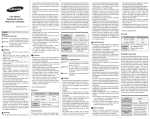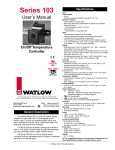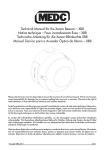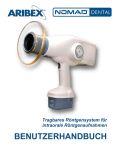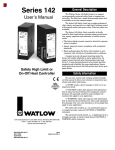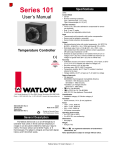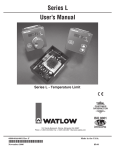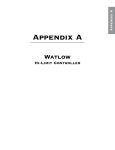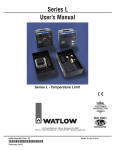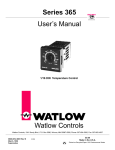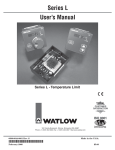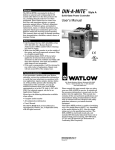Download Watlow Electric SERIES146 User's Manual
Transcript
Series 146 User’s Manual Temperature Regulator TOTAL CUSTOMER SATISFACTION 3 Year Warranty Registered Company Winona, Minnesota USA 1241 Bundy Boulevard, P.O. Box 5580, Winona, Minnesota USA 55987-5580 Phone: +1 (507) 454-5300, Fax: +1 (507) 452-4507, Internet: http://www.watlow.com 0600-0004-0010 Rev D December 2001 Supersedes: 0600-0004-0010 Rev C $5.00 Made in the U.S.A. General Description The Watlow Series 146 is a DIN rail mount, temperature regulating controller with a thermocouple or RTD sensor input. The DIN rail mounting offers quick and easy installation with the use of simple hand tools. The controller may also be flush mounted. The Series 146 is designed to meet the needs of a wide range of safety applications. Factory selectable options include high or low control mode with either manual or automatic reset on power loss. The Series 146 has an LED for output status indication and can be ordered with an integral or remote adjustable set point, or a fixed set point. 1 ■ Watlow Series 146 User’s Manual Specifications (2089) Control Mode • High or low limit, factory selectable • Manual or automatic reset on power loss, factory selectable • Latching alarm with manual reset on over or under temperature • Internal and/or customer supplied external reset switch Operator Interface • LED indication of output status • Dial scale calibrated to compensate for sensor non-linearities • Integral or remote set point • Dual temperature scale (°C and °F) • Fixed set point • Manufactured to specified value Input • Thermocouple or platinum RTD available • Thermocouple with automatic cold junction compensation • Thermocouple may be isolated or grounded • Thermocouple and RTD break protection de-energizes output • 2- or 3-wire RTD input, 100Ω @ 0°C calibrated for 0.003850Ω/Ω °C curve Output • Electromechanical relay, 8A, Form C, SPDT: 8A @ 240VÅ resistive, 8A @ 28VÎ (dc) resistive, 275VA pilot duty rated Accuracy Adjustable Set Point, integral or remote • Calibration accuracy: ±1% of span, at 25°C ± 3°C (77°F ±5°F) ambient and rated line voltage ± 1% • Set point accuracy: ±3% of dial scale • Accuracy span: 540°C (1000°F) minimum Fixed Set Point • Calibration accuracy: ±6°C/±10°F of setting, at 25°C ±3°C (77°F ±5°F) ambient and rated line voltage ±1% Temperature Stability • Thermocouple: Typically 9µV/°C ambient (5µV/°F ambient) input referenced • RTD: Typically 0.2°C/°C ambient (0.2°F/°F ambient) Voltage Stability • ±0.01% of span (min. span of 540°C or 1000°F) per % of rated line voltage Agency Approvals • CE: EN61010 - Safety EN61326 - Industrial Immunity, Class B Emissions Installation Category 2, Pollution Degree 2 • 873, File #E43684 • to C22.2 No. 24, File #E43684 • Approved for use in commercial cooking applications • FM Class 3545, File J.I. 3007307 Terminals • Captive screw, cage clamp connection, 4 mm (0.155 in.) max. width screwdriver blade, 30 to 14-gauge wire Mounting • DIN rail, DIN EN50022, 35 mm x 7.5 mm • Sub-panel flush mounting Power • 24V~, +10%/-15%, 50/60 Hz • 120V~, +10%/-15%, 50/60 Hz • 230V~ to 240~, +10%/-15%, 50/60 Hz • 10VA maximum power Operating Environment • 0 to 55°C (32 to 131°F) • 0 to 90% RH, non-condensing • Storage temperature: -20 to 85°C (-4 to 185°F) Dimensions • Width: 60 mm (2.28 in) • Height: 115 mm (4.45 in) • Depth: 100 mm (3.89 in) Weight • 0.3kg (0.7 lb.) UL® is a registered trademark of Underwriter’s Laboratories, Inc. Note: Specifications subject to change without notice. Dimensions 99 mm (3.89 in.) 95 mm (3.72 in.) Mounting 58 mm (2.28 in.) 41 mm (1.62 in.) Panel DIN Rail Upper Mounting Clip 96 mm (3.75 in.) 104 mm (4.10 in.) Lower Mounting Clip 113 mm (4.45 in.) 35 mm x 7.5 mm Rail is not included in the assembly Release Lever Snap Action Figure 2a — Series 146 dimensions. Figure 2b — Series 146 side view mounting. Wiring Guidelines Installation Sub-Panel Mounting the Series 146 NOTE: FM approval requires limit switches to be suitably enclosed to minimize casual readjustment of set temperature. 1. Using the controller as a location template, mark both mounting holes. 2. Drill two 5 mm (0.19 in.) diameter holes in the desired panel location. See Figure 2a for hole locations. 3. Mount the Series 146 using two #8-32 screws. DIN Rail Mounting the Series 146 1. Place the Series 146 upper mounting clip on the top edge of the DIN rail. See Figure 2b on this page. 2. Press down firmly on the top front edge of the Series 146. The controller “snaps” securely onto the rail. If the controller does not snap on, check to see if the DIN rail is bent. Minimum clipping distance is 34.8 mm (1.37 in.), the maximum is 35.3 mm (1.39 in.). Removing the Series 146 from the DIN Rail 1. Place your fingers on the release lever located at the base of the Series 146. 2. While gently pressing on the top of the case, above Terminals 1-9, pull forward on the release lever. Safety Information Note, caution and warning symbols appear throughout this book to draw your attention to important operational and safety information. A “NOTE” marks a short message to alert you to an important detail. A “CAUTION” safety alert appears with information that is important for protecting your equipment and performance. • Use the correct sensor type per the model number on the unit sticker. • Use the proper thermocouple or RTD polarity. • Insulate the thermocouple mounting from the mounting surface to prevent heat migration input errors. • Thermocouple leads should be twisted pair wire and routed separately from any other lines. • In electrically noisy environments (heavy switching of contactor, motors, solenoids, etc.) use shielded thermocouple lead wire with the shield connected at the sensor end only. • All wiring and fusing must conform to the National Electric Code (NEC) NFPA70 and any other locally applicable codes. • Fuse the independent load voltage on the L1 (hot) side and connect it to the common (COM) side of the relay. ç CAUTION: A power disconnect located near the controller is recommended to shut down power in case of controller failure. • Long lead lengths create electrical resistance. When using a two wire RTD, there will be an additional error for every 1Ω of lead length resistance. That resistance when added to the resistance of the RTD element, can result in erroneous input to the temperature limit. To overcome this problem, use a three wire RTD sensor, which compensates for lead length resistance. When extension wire is used for a three wire RTD, all three extension wires must have the same electrical resistance. (i.e. same gauge, copper stranded. A “WARNING” safety alert appears with information that is important for protecting you, others and equipment from damage. Pay very close attention to all warnings that apply to your application. The ç symbol (an exclamation point in a triangle) precedes a general CAUTION or WARNING statement. The Ó symbol (a lightning bolt in a triangle) precedes an electric shock hazard CAUTION or WARNING safety statement. 2 ■ Watlow Series 146 User’s Manual Power Wiring 120VÅ 146_ - 1 _ _ _ - 0000 230 to 240 VÅ 146_ - 2 _ _ _ - 0000 24VÅ 146_ - 3 _ _ _ - 0000 Power Disconnect Switch Fuse L1 NOTE: The line voltage is specified by your model number. L2 çWARNING: To avoid potential electric shock, use National Electrical Code safety practices when wiring and connecting this unit to a power source and to electrical sensors or peripheral devices. All wiring and fusing must conform to the National Electric Code and to any locally applicable codes. Failure to comply with these recommendations could result in damage to equipment and property, and injury to personnel. 1 15 Recommended fuse size: 1A 3 çWARNING: The Series 146 safety limit should be mounted in an inconspicuous location to discourage unauthorized changes to the set point. Only approved and appropriate personnel should have the authority to change the set point on the limit switch. Failure to comply with these recommendations could result in damage to equipment and property, and injury to personnel. çCAUTION: Applying incorrect voltage may result in irreversible damage to the controller. Figure 3a — Power wiring. Input Wiring Output Wiring Electromechanical Relay, Form C Thermocouple 8A ç 146E - _ _ _ _ - _ 000 L1 Fuse L2 Customer Supplied Quencharc C 15 External Device NO 5 7 NC High Temperature Light 9 10 11 + – Figure 3b — Thermocouple wiring. 2- and 3-Wire RTD NOTE: Switching inductive loads (relay coils, solenoids, etc.) with the mechanical relay, switched dc or solidstate relay output options requires use of an R.C. Suppressor. Watlow carries the R.C. suppressor Quencharc brand name, which is a trademark of ITW Paktron. Watlow Part No. 0804-0147-0000. Figure 3d — Electromechanical relay wiring. Remote Reset NOTE: The Series 146 used with a remote reset may affect FM recognition. Only the use of a momentary switch is valid for approval. 10 11 12 10 11 12 S3 S3 S1 NOTE: Reset is customer-supplied. S2 S2 2-wire RTD S1 13 14 15 16 17 3-wire RTD Figure 3e — Remote reset wiring. Figure 3c — 2- and 3-Wire RTD Wiring NOTE: 2- or 3-wire RTD input, calibrated for 0.003850Ω/Ω °C curve. Customer-Supplied Reset 3 ■ Watlow Series 146 User’s Manual System Example Power Disconnect Switch L1 120V~ L2 Customer Supplied Quencharc Fuse Fuse Fuse High Limit Mechanical Contactor coil Fuse C NO NC 1 2 S E N S O R HighTemperature Light 1 2 3 4 5 6 7 8 9 3 4 500 5 550 600 650 450 700 400 + SSR-240-10A-DC1 in out Solid-State Relay - 750 350 800 300 Series 102 Temperature Controller 102C-16XX-1000 Heater Process Sensor 10 11 12 13 14 15 16 17 Limit Sensor Series 146 Limit Control 146E-16XX-1000 Reset Switch (Customer Supplied) 120VÅ L1 L2 Power Disconnect Switch 1 1 1 3 4 (+) 2 5 (-) 3 2 2 Series 102 Temperature Controller 102C-16XX-1000 3 4 5 6 7 SSR-240-10A-DC1 Solid-State Relay 3 to 32 (+) VÎ (dc) in. (-) 1 CR-1 5 1 8 1 11 6 48 to 260 VÅ out 9 1 7 8 14 (+) 10 9 10 15 (-) 11 12 1 17 13 2 3 2 12 Series 146 13 146E-16XX-1000 Temperature Limit 14 13 11 5 Heater 10 7 NO 16 Com 9 NC 18 1 CR R 2 2 High-Temperature Light Figure 4 — System wiring examples. 4 ■ Watlow Series 146 User’s Manual Declaration of Conformity Erklärt, daß das folgende Produkt: Deutsch Beschreibung: Serie 146 Modellnummer(n): 146E - (1, 2 oder 3) (100-999) - (1, 2, 3 oder 4) (Drei beliebige Buchstaben oder Ziffern) Klassifikation: Regelsystem, Installationskategorie II, Emissionsgrad II Nennspannung: 24, 120 oder 240V Nennfrequenz: 50/60 Hz Nominaler Stromverbrauch: Maximaler 10VA Series 146 WATLOW WINONA 1241 Bundy Boulevard Winona, Minnesota 55987 USA Declares that the following product: Erfüllt die wichtigsten Normen der folgenden Anweisung(en) der Europäischen Union unter Verwendung des wichtigsten Abschnitts bzw. der wichtigsten Abschnitte die unten zur Befolgung aufgezeigt werden. English 89/336/EEC Elektromagnetische Übereinstimmungsanweisung Designation: Series 146 Model Numbers: 146E - (1,2 or 3) (100-999) - (1, 2, 3 or 4) (Any three letters or numbers) Classification: Temperature control, Installation Category II, Pollution degree II Rated Voltage: 24, 120 or 240 V~ (ac) Rated Frequency: 50 or 60 Hz Rated Power Consumption: 10 VA maximum Meets the essential requirements of the following European Union Directives by using the relevant standards shown below to indicate compliance. EN 61326:1997 With A1:1998 - Sicherheitsrichtlinien für Elektrogeräte zur Messung, zur Steuerung und im Labor - EMC Erfordernis (Industrieimmunität, Klasse A Emission). EN 61000-4-2:1996 With A1, 1998 - Elektrostatische Entladungsimmunität EN 61000-4-3:1997 - Strahlungsfeldimmunität EN 61000-4-4:1995 - Elektrische schnelle Stöße/Burstimmunität EN 61000-4-5:1995 With A1, 1996 - Spannungsstoßimmunität EN 61000-4-6:1996 - Störimmunität EN 61000-4-11:1994 Spannungsabfall, Kurze Unterbrechungen und Spannungsschwankungsimmunität EN 61000-3-2:1995 With A1-3:1999 - Grenzen der Oberwellenstromemissionen EN 61000-3-3:1995 With A1:1998 - Spannungsschwankungen und Flimmern 89/336/EEC Electromagnetic Compatibility Directive EN 61326:1997 With A1:1998 - Electrical equipment for measurement, control and laboratory use - EMC requirements (Industrial Immunity, Class A Emissions). EN 61000-4-2:1996 With A1, 1998 - Electrostatic Discharge Immunity EN 61000-4-3:1997 - Radiated Field Immunity EN 61000-4-4:1995 - Electrical Fast-Transient / Burst Immunity EN 61000-4-5:1995 With A1, 1996 - Surge Immunity EN 61000-4-6:1996 - Conducted Immunity EN 61000-4-11:1994 Voltage Dips, Short Interruptions and Voltage Variations Immunity EN 61000-3-2:1995 With A1-3:1999 - Harmonic Current Emissions EN 61000-3-3:1995 With A1:1998 - Voltage Fluctuations and Flicker 73/23/EEC Low-Voltage Directive EN 61010-1:1993 With A1:1995 Safety Requirements of electrical equipment for measurement, control and laboratory use. Part 1: General requirements déclare que le produit suivant : Français Désignation : Série 146 Numéros de modèle : 146E - (1,2 ou 3) (100-999) - (1, 2, 3 ou 4) (N'importe quelle combinaison de trois lettres ou chiffres) Classification : Régulation de température, Catégorie d'installation II, Degré de pollution II Tension nominale : 24, 120 ou 240V~ (c.a) Fréquence nominale : 50 ou 60 Hz Consommation d'alimentation nominale : 10 VA maximum Répond aux normes essentielles des directives suivantes de l'Union européenne en utilisant les standards normalisés ci-dessous qui expliquent les normes auxquelles répondre : Directive 89/336/CEE sur la compatibilité électromagnétique EN 61326:1997 avec A1 :1998 - Matériel électrique destiné à l'étalonnage, au contrôle et à l'utilisation en laboratoire - Exigences CEM (Immunité industrielle, Émissions de catégorie A). EN 61000-4-2:1996 Avec A1, 1998 - Immunité aux décharges électrostatiques EN 61000-4-3:1997 - Immunité aux champs de radiation EN 61000-4-4:1995 - Immunité contre les surtensions électriques rapides/ Rafale EN 61000-4-5:1995 avec A1, 1996 - Immunité contre les surtensions EN 61000-4-6:1996 - Immunité conduite EN 61000-4-11:1994 Immunité contre les écarts de tension, interruptions courtes et variations de tension EN 61000-3-2:1995 avec A1-3 :1999 - Emissions de courant harmoniques EN 61000-3-3:1995 avec A1 :1998 - Fluctuations et vacillements de tension Directive 73/23/CEE sur les basses tensions EN 61010-1:1993 avec A1 :1995 Normes de sécurité du matériel électrique pour la mesure, le contrôle et l'utilisation en laboratoire. 1ère partie : Conditions générales 73/23/EEC Niederspannungsrichtlinie zu entsprechen EN 61010-1:1993 mit A1:1995 Sicherheitsrichtlinien für Elektrogeräte zur Messung, zur Steuerung und im Labor, Teil 1: Allgemeine Richtlinien Declara que el producto siguiente: Español Designación: Serie 146 Números de modelo: 146E - (1, 2 ó 3) (100-999) - (1, 2, 3 ó 4) (Cualquier combinación de tres números y letras) Clasificación: Control de temperatura, Categoría de instalación II, grado de contaminación ambiental II Tensión nominal: 24, 120 ó 240V Frecuencia nominal: 50/60 Hz Consumo nominal de energía: 10 VA máximo Cumple con los requisitos esenciales de las siguientes Directivas de la Unión Europea mediante el uso de las normas pertinentes que se muestran a continuación para indicar su acatamiento. 89/336/EEC Directiva de compatibilidad electromagnética EN 61326:1997 CON a1:1998.- Equipo eléctrico para medición, control y uso en laboratorio - Requisitos EMC (Inmunidad industrial, Emisiones Clase A). EN 61000-4-2:1996 con A1, 1988 - Inmunidad a descarga electrostática EN 61000-4-3:1997 - Inmunidad a campo radiado EN 61000-4-4:1995 - Inmunidad a incremento repentino/rápidas fluctuaciones eléctricas transitorias EN 61000-4-5:1995 con A1, 1996 - Inmunidad a picos de voltaje o corriente EN 61000-4-6:1996 - Inmunidad por conducción EN 61000-4-11:1994 Inmunidad a caídas de voltaje, variaciones y pequeñas interrupciones de voltaje EN 61000-3-2:1995 CON a1-3:1999 - Emisiones de corriente armónica EN 61000-3-3:1995 con A1:1998 - Fluctuaciones de voltaje y centelleo 73/23/EEC Directiva de bajo voltaje EN 61010-1:1993 con A1:1995 Requisitos de seguridad de equipo eléctrico para medición, control y uso en laboratorio. Parte 1: Requisitos generales Jim Boigenzahn Name of Authorized Representative Winona, Minnesota, USA Place of Issue General Manager Title of Authorized Representative August 2001 Date of Issue Signature of Authorized Representative (2013) 5 ■ Watlow Series 146 User’s Manual Ordering Information Warranty 146 _ - _ _ _ _ - _ _00 (2012) Output Type E = Electromechanical relay, 8A, Form C Line Voltage 1 = 120VÅ 2 = 230VÅ to 240VÅ 3 = 24VÅ Input and Range Type E 619 = 0 to 799°C (32 to 1470°F) Type J 601 = 0 to 315°C (32 to 600°F) 602 = 0 to 750°C (32 to 1382°F) 615 = Fixed at 315°C (600°F) 618 = -17 to 93°C (0 to 200°F) 620 = 149 to 427°C (300 to 800°F) 623 = 43 to 54°C (110 to 130°F) 625 = 121 to 221°C (250 to 430°F) Type K 603 = 0 to 1250°C (32 to 2282°F) 611 = 0 to 600°C (32 to 1112°F) 626 = 16 to 149°C (60 to 300°F) 627 = 0 to 66°C (32 to 150°F) 628 = -17 to 315°C (0 to 600°F) Type T 629 = -200 to 350°C (-328 to 662°F) 632 = Fixed at -75°C (-103°F) RTD 101 = -73 to 600°C (-100 to 1112°F) (100Ω) 104 = -73 to 600°C (-100 to 1112°F) (1000Ω) 105 = 0 to 80°C (32 to 176°F) 106 = Fixed at 200°C (392°F) 107 = Fixed at 350°C (662°F) 108 = Fixed at 110°C (230°F) 109 = Fixed at 150°C (302°F) 110 = Fixed at 120°C (248°F) 111 = Fixed at 250°C (482°F) Limit Mode 1 = High limit, manual reset on power loss 2 = Low limit, manual reset on power loss 3 = High limit, automatic reset on power loss 4 = Low limit, automatic reset on power loss Remote Options 0 = Regulating control, integral setpot N = Regulating control, no setpot, customer provided S = Regulating control, remote setpot with remote reset P = Regulating control, remote setpot NOTE: Electromechanical relays are typically warranted for 100,000 closures only. The Series 146 is warranted to be free of defects in material and workmanship for 36 months after delivery to the first purchaser for use, providing that the unit has not been misapplied. Since Watlow has no control over its use or misuse, we cannot guarantee against failure. Watlow’s obligations hereunder, at Watlow’s option, are limited to replacement or refund of purchase price of a unit which upon examination proves to be defective within the warranty period. This warranty does not apply to damage resulting from transportation, alteration, misuse or abuse. Returns • Call or fax Customer Service for a Return Material Authorization (RMA) number before returning a product. • Put the RMA number on the shipping label, and also a description of the problem. • A 20% of net price restocking charge applies to all standard units returned to stock. Contact: • Phone: 507/454-5300 • Fax: 507/452-4507 Technical Support If you encounter a problem with your Watlow controller, verify that your wiring is correct for your specific model number. If the problem persists, an Application Engineer can discuss your application with you. Before calling, please have the complete model number and user’s manual available. You can get technical support by dialing 507/454-5300, 7 a.m. to 7 p.m. Central Standard Time. The Series 146 User’s Manual is copyrighted by Watlow Inc., © 2001, with all rights reserved. (1965) Note: User documentation may be available in French, German, Spanish, Italian, and Dutch, as well as English. Check Watlow’s website (www.watlow.com/) for availability. Specify language at time of order. Troubleshooting Problem The load will not turn on. The load will not turn off. Probable Cause Action An open sensor Repair or replace. The load circuit is open. Check the fuses, circuit breakers, load and wiring. The ac input is not connected or is connected improperly. Check the ac input connections. If not present, connect per Power Wiring, page 3. The polarity is reversed on the thermocouple. Connect per Input Wiring, page 4. A faulty unit. Remove power to the controller and the controller from the system. Apply power to the system with the controller removed. If the load turns off, return the controller to the factory. If the load remains on, there are other problems in the system that must be resolved. Consult the factory.






